Recruitment is no longer just about posting job ads and sifting through resumes. It’s a process that has been entirely transformed by AI. Recruiters no longer spend endless hours sorting through applications or scheduling interviews manually.
Instead, they now leverage advanced tools that can automate the tedious parts of recruitment and focus on what ruly matters: finding the right talent.
One of the most powerful tools leading this change is the recruitment chatbot. These AI-driven assistants can handle everything from screening resumes to providing instant feedback to candidates, making the process faster, smarter, and more engaging.
By the end of this blog discussing recruitment chatbot case studies, you'll see just how effective these chatbots can be in solving some of the most common hiring challenges.
Why Recruitment Chatbots are Essential in Today's Hiring Landscape
Traditional recruitment is usually slow and costly where as chatbots can screen resumes, schedule interviews, and answers questions in minutes—no coffee breaks needed.
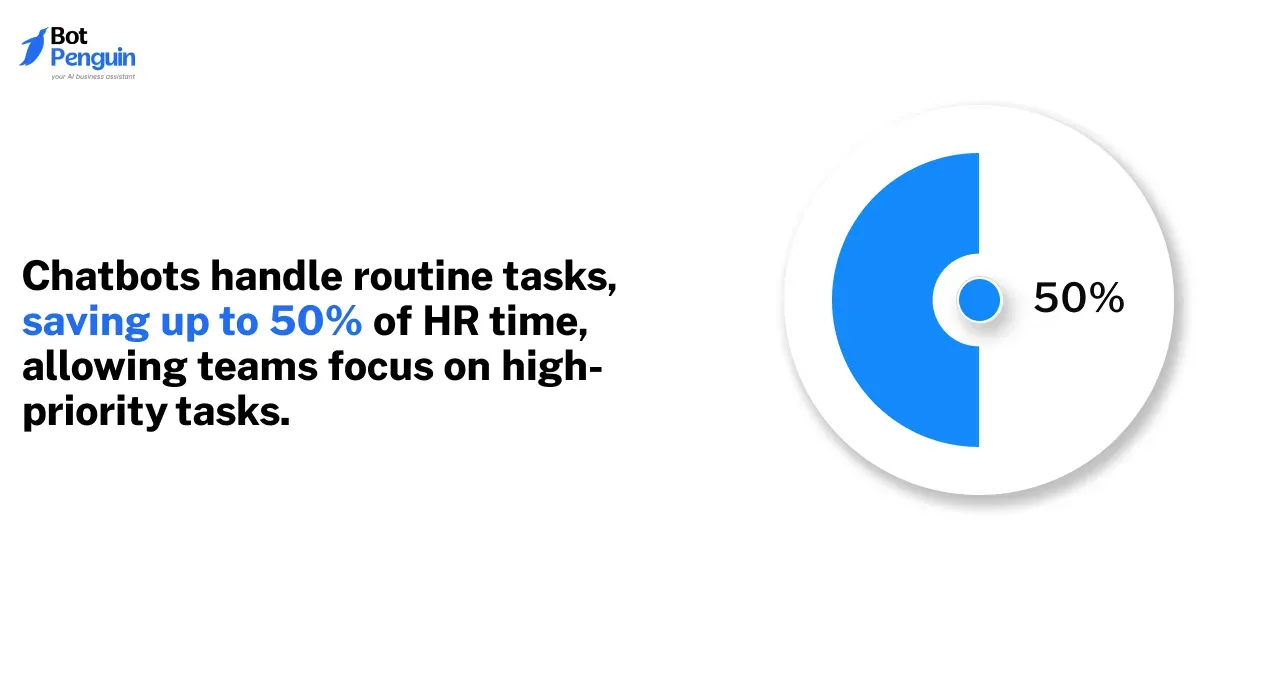
As demand for recruitment increase, HR teams struggle with time-consuming tasks. Chatbots automate these, speeding up hiring and reducing time taken. Research shows chatbots can cut costs by 30% and boost efficiency by 40% (McKinsey).
Here’s how chatbots are making recruitment faster, smarter, and more efficient:
- Speed and Efficiency: Chatbots handle routine tasks, saving up to 50% of HR time, allowing teams focus on high-priority tasks.
- Enhanced Candidate Experience: Instant feedback and personalized messages boost application completion by 35% (Jobvite), improving candidate engagement.
- Scalability: Chatbots manage high volume of application , ensuring smooth recruitment even during peak seasons, like Walmart’s peak hiring (Recruitment chatbot case study 7%).
- Improved Hiring Outcomes: Chatbots reduce bias by evaluating candidates based on qualifications, not gut feelings, leading to more diverse, qualified hires (Harvard Business Review).
7 Recruitment Chatbot Case Studies
Discover how top companies are using AI chatbots to make hiring faster, easier, and more engaging in these recruitment chatbot case studies.
These case studies show how chatbots streamline recruitment, improve candidate experiences, and helping businesses hire smarter and more efficiently.
1. KLM Royal Dutch Airlines: Enhancing Candidate Experience with a Travel-Themed Bot
KLM Royal Dutch Airlines uses a travel-themed recruitment chatbot, "BB," to provide a personalized and fun experience for candidates.
Background
KLM’s chatbot “BB” was designed to reflect the airline’s playful and engaging brand personality.
The goal was to make the recruitment process as enjoyable as a flight. Instead of a simple form submission, applicants are greeted by a chatbot that offers them a personalized experience.
Implementation
BB answers candidate inquiries, screens resumes, and helps applicants navigate the recruitment process.
The chatbot asks questions about qualifications, offers details about job roles, and even provides tips on what to expect during the interview process.
Results
KLM’s use of BB has led to increased engagement with potential candidates, creating a memorable hiring experience.
The chatbot has helped filter candidates more efficiently, ensuring that only those with the right qualifications make it to the next stage.
2. Mayo Clinic: Automating Screening for Healthcare Roles
By integrating a recruitment chatbot, Mayo Clinic significantly boosted its hiring efficiency and candidate experience.
Mayo Clinic adopted an AI-driven recruitment chatbot to streamline the hiring process for its healthcare roles, drastically improving efficiency.
Background
Mayo Clinic faces an enormous volume of applications for its healthcare positions, making manual screening a labor-intensive and time-consuming task.
To combat this, the organization turned to AI to automate the initial stages of recruitment.
Implementation
The chatbot automatically screens the resumes, assesses qualifications, and filters out candidates who don’t meet the necessary criteria.
It even sends follow-up questions and updates to applicants, keeping the process moving efficiently. HR teams can now focus on interviewing the most qualified candidates rather than sifting through hundreds of resumes.
Results
By automating the screening process, Mayo Clinic saved valuable hours in the recruitment cycle. The hospital system reported a significant reduction in screening time, cutting it by 50%, while increasing hiring accuracy.
The results were clear: they witnessed faster hiring, better candidate experience, and more time for HR to focus on strategic tasks.
3. Sephora: Engaging Candidates with Personalized Conversations
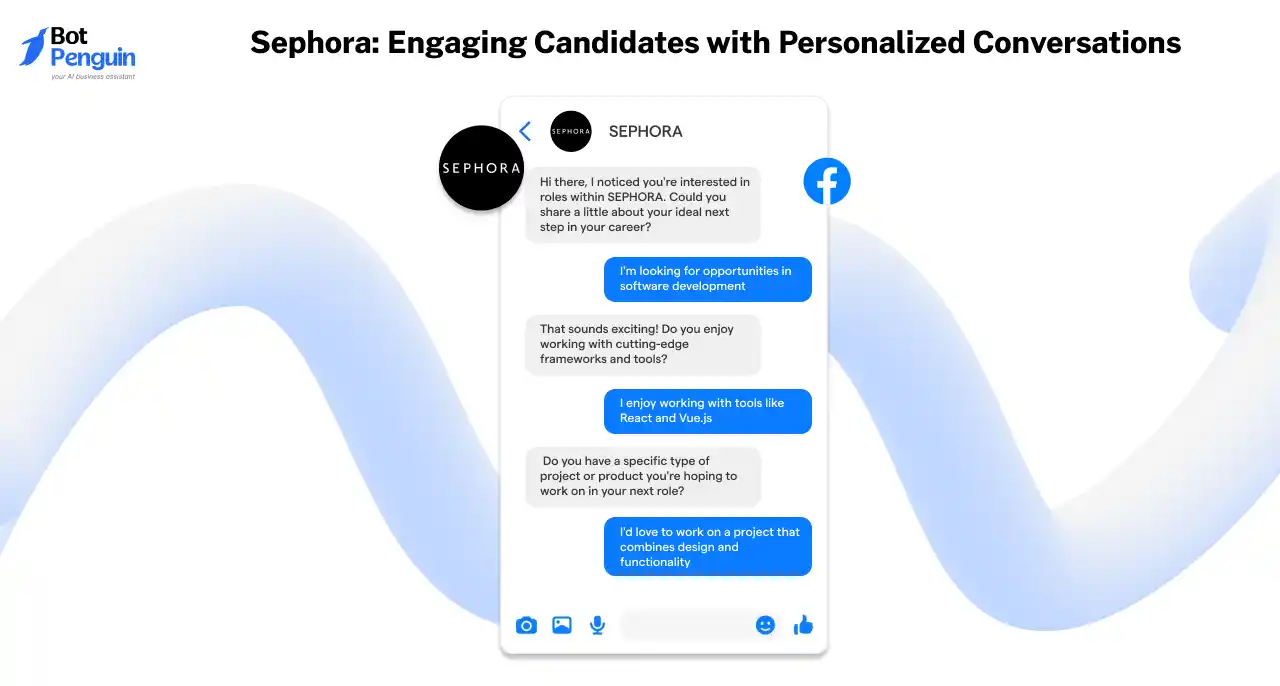
Sephora has embraced AI-powered chatbots to provide a more engaging and personalized recruitment experience, ensuring a seamless process for potential hires.
Background
Sephora recognized the need to connect with candidates in a way that felt more personal and aligned with its brand.
They used a chatbot to engage potential hires in conversations that go beyond just job descriptions. The goal was to recommend jobs based on candidates' preferences, experiences, and skills.
Implementation
The chatbot acts as a virtual recruiter, engaging applicants in real-time and guiding them through the application process. By using AI, it can suggest roles that match a candidate’s profile and interests.
The chatbot also streamlines the scheduling process, making it easy to book interviews, and offers reminders to keep candidates informed at every step.
Results
Since integrating the chatbot, Sephora has seen a notable improvement in candidate engagement and satisfaction.
The tailored job recommendations led to more relevant applications, while the streamlined process resulted in higher completion rates.
By creating a more personalized experience, Sephora successfully reduced candidate drop-off and boosted its brand image.
4. L'Oréal: Reducing Time-to-Hire with Automated Screening
L'Oréal is leveraging AI to make their recruitment process faster, smarter, and more efficient—ultimately helping them stay competitive on the global stage.
L'Oréal is a global leader in beauty products, and hiring at scale across diverse regions poses a unique set of challenges.
Background
L'Oréal’s recruitment process involves large volumes of candidates, especially across different countries and regions.
Managing this with a traditional approach would be time-consuming and inefficient, especially when catering to a wide range of local markets with varied needs.
Implementation
To streamline the hiring process, L'Oréal adopted a recruitment chatbot to handle initial screening and pre-interview tasks. The bot automatically reviews resumes, screens candidates based on job requirements, and conducts first-round interviews.
It is also capable of assessing key qualifications, helping the HR team focus only on the most relevant candidates. The bot is multilingual, enabling L'Oréal to serve different regions in their respective languages, ensuring an inclusive and efficient process globally.
Results
The chatbot has significantly reduced the time-to-hire for L'Oréal’s global workforce. Automated screening allows the team to identify top candidates quickly, leading to faster interviews and decisions.
The system also ensures high-quality applicants which is done by filtering out those who don’t meet eligibility criteria.
By automating routine tasks, L'Oréal can handle hiring at scale without sacrificing candidate quality, improving both the hiring speed and the candidate experience.
5. Walmart: Managing High-Volume Hiring with a Chatbot
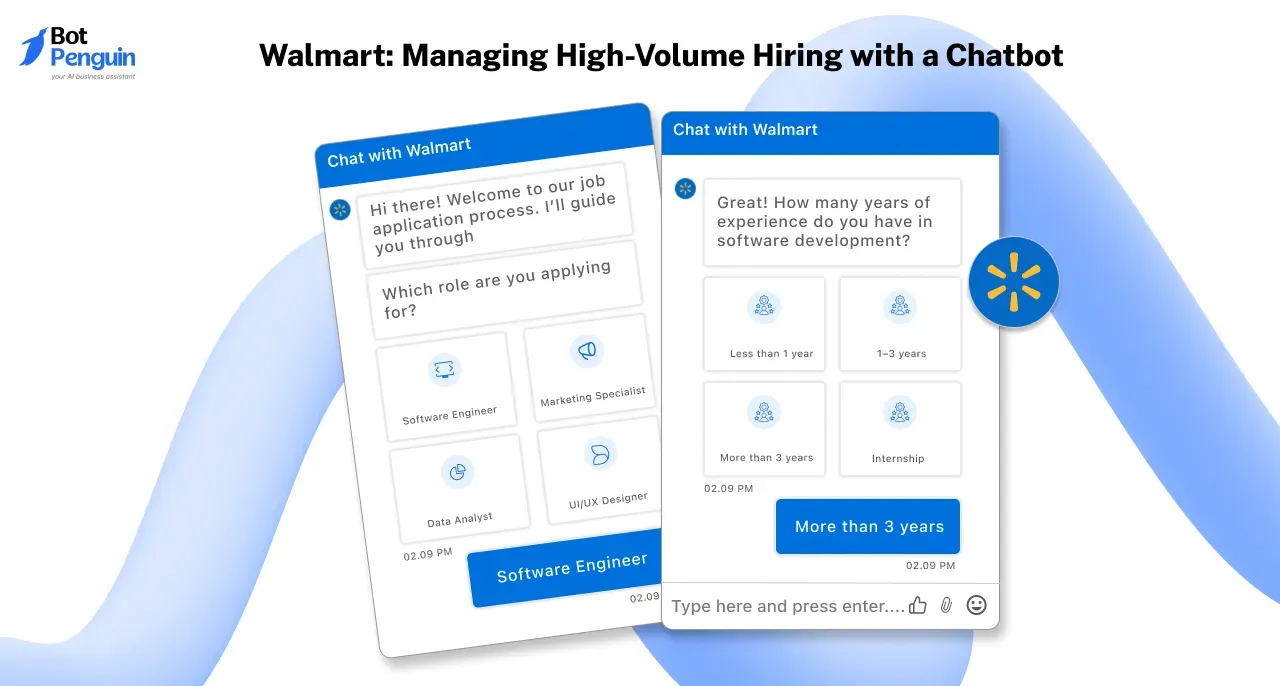
Walmart is using AI to make high-volume hiring easier, faster, and more effective. We’ll look at how they’ve integrated the chatbot into their recruitment process, the results they’ve seen, and how you can do the same for your business.
Walmart is one of the world’s largest employers, processing thousands of applications every day across various locations. The challenge? Managing this volume efficiently without compromising on the quality of hires.
Background
Walmart’s hiring process needs to accommodate an enormous volume of applicants, especially during peak seasons like holidays.
With hundreds of locations and multiple positions, traditional recruitment methods simply weren’t scalable.
Implementation
To meet this challenge, Walmart has adopted a recruitment chatbot to handle the initial stages of the hiring process. The chatbot conducts preliminary screenings, filters candidates based on qualifications, and even schedules interviews.
It collects key information from applicants and guides them through the process, making the experience more efficient for both candidates and hiring managers.
Results
The chatbot has drastically reduced the time-to-hire by processing applications quickly and ensuring only qualified candidates make it through to the next stage.
Walmart can now manage a much larger volume of applicants without needing additional HR staff.
Candidate engagement has also improved, with higher levels of interaction and a smoother application process. Ultimately, Walmart’s adoption of the recruitment chatbot has led to faster hires and a more positive experience for applicants.
Suggested Reading:
7 Recruitment Process Automation Strategies for Faster Hiring
6. Breezeway: AI Chatbot for Property Maintenance Hiring
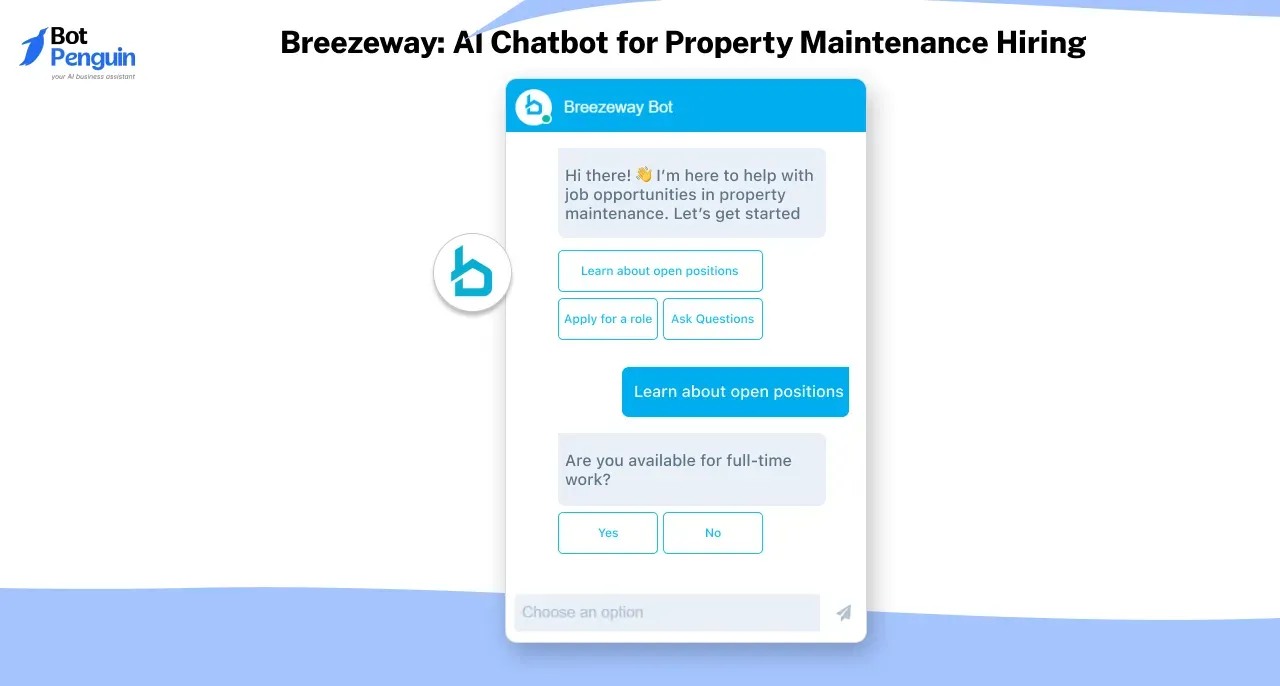
Breezeway’s recruitment faced a challenge to focus on hiring qualified maintenance workers quickly.
In the competitive property management industry, they needed a solution that could automate the hiring of skilled labor without compromising on quality.
Background
As a property management company, Breezeway specializes in maintaining and managing properties at scale. One of the biggest hiring challenges they faced was filling maintenance roles with qualified workers.
These roles require specific skills, such as plumbing or electrical work, which can be hard to match with applicants quickly.
Implementation
To solve this, Breezeway integrated a recruitment chatbot into their hiring process. The chatbot asked applicants a series of targeted questions about their skills, experience, certifications, and availability.
By automating this step, Breezeway could quickly assess which candidates were qualified for the roles, streamlining the entire process.
Results
The implementation of the chatbot reduced the time-to-hire significantly, allowing Breezeway to quickly fill maintenance positions.
With higher engagement rates, candidates felt more involved in the process, resulting in better job matching. The chatbot also improved the company’s ability to filter out unqualified applicants, ensuring only the best candidates moved forward.
7. PepsiCo: Multi-Channel Chatbot for Streamlined Candidate Engagement
PepsiCo’s recruitment efforts are global, reaching diverse talent across multiple regions.
To meet this challenge, they adopted a chatbot capable of engaging with candidates through several platforms, making communication seamless and instant.
Background
PepsiCo aims to attract talent from a variety of regions and backgrounds. With a large pool of potential candidates, the company needed a way to effectively engage with applicants across multiple platforms and streamline the process.
The goal was to reach candidates where they already are—on social media, job boards, and the company’s own career site.
Implementation
PepsiCo deployed a chatbot integrated with LinkedIn, Facebook, and their career page, enabling the bot to answer questions, provide information about job opportunities, and guide candidates through the application process.
This multi-channel approach allowed PepsiCo to engage with candidates instantly, regardless of the platform they were using.
Results
By leveraging the chatbot, PepsiCo was able to significantly increase candidate engagement. The chatbot’s ability to respond instantly led to faster response times, and the application completion rate saw noticeable improvements.
The scalability of the solution also allowed PepsiCo to expand its reach to diverse global markets, offering an inclusive and efficient recruitment experience.
The Future of Recruitment: Why Chatbots Are Here to Stay
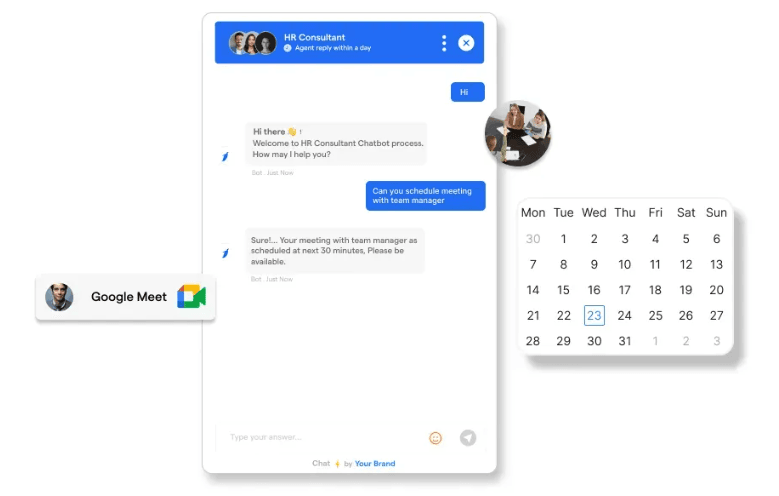
Traditional hiring methods are very slow for today’s fast-paced job market. Recruitment chatbots are the solution, automating tasks and speeding up hiring.
As the demand for faster, smarter recruitment grows, chatbots like BotPenguin are helping companies stay competitive.
They handle tasks like resume screening, interview scheduling, and answering candidate questions, freeing up HR teams to focus on high-priority work.
The Growing Demand for Recruitment Automation
Recruitment automation is crucial as application volumes rise. BotPenguin streamlines administrative tasks thereby making the process faster and more efficient.
- Boosting Efficiency: Chatbots save HR time by automating routine tasks, allowing focus on strategic hiring decisions.
- Improved Candidate Experience: Fast, personalized responses keep candidates engaged and reduce drop-off rates.
- Addressing the Skills Shortage: With the talent shortage, chatbots help manage high volumes of applications efficiently.
Companies like L'Oréal use chatbots to avoid missing qualified candidates during peak hiring seasons.
- Faster Hiring: Chatbots speed up resume screening and interview scheduling.
- High-Volume Hiring: Chatbots process large numbers of applicants without losing quality.
Chatbots are transforming recruitment, making it faster, smarter, and more efficient. As hiring demands increase, tools like BotPenguin are key to success.
Conclusion: How Chatbots are Revolutionizing Recruitment
Recruitment is evolving fast, and chatbots are leading the charge. By automating repetitive tasks, improving candidate engagement, and speeding up hiring workflows, AI is reshaping how companies hire.
Key Takeaways
Chatbots enhance efficiency, boost candidate experience, and accelerate hiring, offering businesses a competitive edge in talent acquisition.
- Automation at Scale: Chatbots, like BotPenguin, handle time-consuming tasks like screening, scheduling, and engagement. This allows HR teams to focus on higher-value work, like building relationships with top candidates.
- Improved Candidate Experience: Job seekers appreciate the instant responses and personalized engagement that chatbots provide. This creates a smoother, more enjoyable hiring experience and increases the likelihood of completed applications.
- Faster Hiring and Better Results: Companies using chatbots report significant improvements in time-to-hire, candidate quality, and overall recruitment efficiency. This helps businesses keep up with high hiring demands and stay competitive.
Investing in recruitment chatbots, like BotPenguin, is about creating a faster, more effective, and scalable hiring process that benefits both HR teams and candidates.
As the technology improves, companies that embrace AI will have a distinct advantage in attracting top talent.
Frequently Asked Questions (FAQs)
What is a recruitment chatbot?
A recruitment chatbot is an AI-powered tool that automates hiring tasks like screening, scheduling, and answering candidate questions, improving efficiency and candidate engagement.
How can recruitment chatbots improve candidate experience?
Chatbots provide instant responses, personalized interactions, and 24/7 availability, making the application process smoother and faster.
What are the benefits of using BotPenguin for recruitment?
BotPenguin automates screening, scheduling, and FAQs, reducing time-to-hire, improving candidate quality, and enhancing recruitment efficiency, allowing HR teams to focus on higher-priority tasks.
How much time can chatbots save in the hiring process?
Recruitment chatbots can reduce the time-to-hire by up to 60%, automating repetitive tasks and speeding up initial screenings and interview scheduling.
Are recruitment chatbots scalable for large organizations?
Yes, chatbots like BotPenguin are highly scalable, handling large volumes of applications across regions and improving recruitment efficiency for companies with diverse, high-demand hiring needs.



